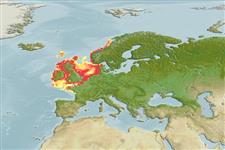Environment: milieu / climate zone / depth range / distribution range
Ecologia
marinhas; estuarina demersal; oceanódromo (Ref. 51243); intervalo de profundidade 0 - 100 m (Ref. 35388), usually 10 - 20 m (Ref. 1371). Temperate; 68°N - 44°N, 11°W - 13°E
Northeast Atlantic: Trondheim on the Norwegian coast to the Bay of Biscay; also around the British Isles.
Tamanho / Peso / Idade
Maturity: Lm ? range ? - ? cm
Max length : 30.0 cm TL macho/indeterminado; (Ref. 1371); common length : 20.0 cm TL macho/indeterminado; (Ref. 4645)
Espinhos dorsais (total) : 0; Espinhos anais: 0. Head depressed. First dorsal fin poorly developed, with only three short rays. Color uniformly dark brown or bluish brown; the lips and the distal areas of all fins paler except for the pectorals.
Lives in coastal waters at shallow depths, generally from 10-20 m, more seldom from 75-100 m, on rocky bottom with seaweeds. Solitary and secretive, undertakes only limited local movements. Spawns from May to September at 50-70 m depth near the shore throughout its entire range. Feeds on sea stars, crustaceans, worms, mollusks and small fish (Ref. 1371).
Ciclo de vida ou comportamento de acasalamento
Maturidade | Reprodução | Desova | Ovos | Fecundidade | Larvas
Oviparous, sexes are separate (Ref. 205).
Cohen, D.M., T. Inada, T. Iwamoto and N. Scialabba, 1990. FAO species catalogue. Vol. 10. Gadiform fishes of the world (Order Gadiformes). An annotated and illustrated catalogue of cods, hakes, grenadiers and other gadiform fishes known to date. FAO Fish. Synop. 125(10). Rome: FAO. 442 p. (Ref. 1371)
Status na Lista Vermelha da UICN (Ref. 130435: Version 2024-1)
Ameaça para os humanos
Harmless
Uso pelos humanos
Pescarias: sem interesse; Aquário: Aquários públicos
Ferramentas
Relatórios especiais
Baixar XML
Fontes da internet
Estimates based on models
Preferred temperature (Ref.
123201): 8.5 - 12.5, mean 10.4 °C (based on 120 cells).
Índice de diversidade filogenética (Ref.
82804): PD
50 = 1.0000 [Uniqueness, from 0.5 = low to 2.0 = high].
Bayesian length-weight: a=0.01072 (0.00408 - 0.02815), b=3.05 (2.83 - 3.27), in cm total length, based on LWR estimates for this (Sub)family-body shape (Ref.
93245).
Nível Trófico (Ref.
69278): 3.8 ±0.56 se; based on food items.
Fishing Vulnerability (Ref.
59153): Low vulnerability (20 of 100).
Nutrients (Ref.
124155): Calcium = 28.6 [14.3, 51.4] mg/100g; Iron = 0.331 [0.207, 0.536] mg/100g; Protein = 18.4 [17.1, 19.6] %; Omega3 = 0.565 [0.290, 1.051] g/100g; Selenium = 13.7 [7.3, 26.5] μg/100g; VitaminA = 10.4 [3.7, 28.5] μg/100g; Zinc = 0.565 [0.427, 0.763] mg/100g (wet weight);
